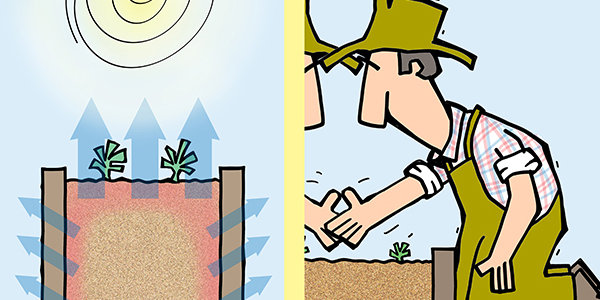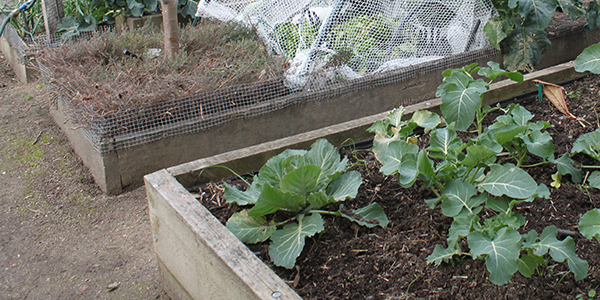This page explains how wicking beds work and lists the positives and negatives of wicking beds in comparison to standard raised beds.
A wicking bed is a raised garden bed with a waterproof lining that holds a reservoir of water at the bottom from which water is drawn upwards like a wick to the surface of the bed via natural soil osmosis or through the roots of plants in the bed. Basically it works like a large self-watering pot.
Wicking beds are usually made with timber sides and a pond liner at the bottom to act as a water reservoir, but they can also be made out of plastic tubs or any other container that holds water and does not corrode when in contact with soil.

Profile of a simple wicking bed and the various components that are used in the bed. There are more complex wicking bed designs available but this page does not cover them.
Wicking beds have both benefits and drawbacks, Below is a summary of their advantages and disadvantages to help you decide whether wicking beds will meet your gardening needs.

- USE BETWEEN 40 AND 50% LESS WATER THAN A CONVENTIONAL RAISED BED
- HARDER FOR WEEDS TO ESTABLISH
This is because the soil on the surface is drier due to it being watered from below. - REQUIRES LESS FREQUENT WATERING
Making it possible to go away for several days in warmer weather without the wicking beds drying out. - REDUCES THE RISK OF INVASIVE ROOTS GETTING INTO THE BED
This makes wicking beds ideal for gardens that have trees with invasive roots or are infested with Couch grass. - CAN BE WATERED USING A LOW PRESSURE WATERING SYSTEM
Meaning it can be connected to a water tank via the use of a low pressure float valve without the use of a pressure pump.
- MORE EXPENSIVE TO BUILD
The cost of a wicking bed is approximately three to four times that of a conventional raised garden bed. - HARDER TO BUILD
As the design is more complicated they take longer to build and require a higher level of building skills. - SOIL MORE PRONE TO FUNGAL DISEASES
When the reservoir has water in it the underlying soil remains damp, which creates ideal conditions for fungal diseases such as fusarium wilt. - USE MORE MATERIALS
A raised bed requires a lot more materials to build than a conventional garden bed.
ADVANTAGES SUMMARY
ADVANTAGES
- USE BETWEEN 40 AND 50% LESS WATER THAN A CONVENTIONAL RAISED BED
- HARDER FOR WEEDS TO ESTABLISH
- REQUIRES LESS FREQUENT WATERING
- REDUCES THE RISK OF INVASIVE ROOTS GETTING INTO THE BED
-
CAN BE WATERED USING A LOW PRESSURE WATERING SYSTEM
DISADVANTAGES SUMMARY
DISADVANTAGES
- MORE EXPENSIVE TO BUILD
- HARDER TO BUILD.
- SOIL MORE PRONE TO FUNGAL DISEASES
-
USE MORE MATERIALS




